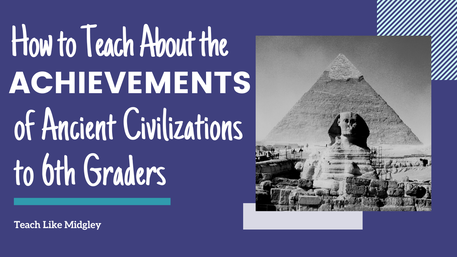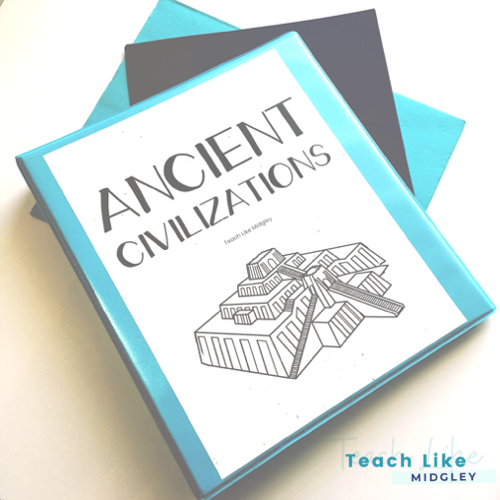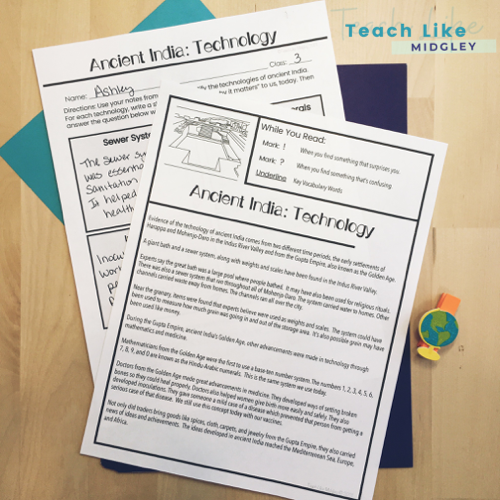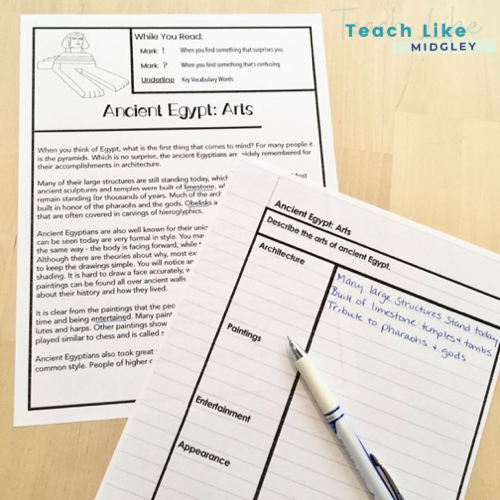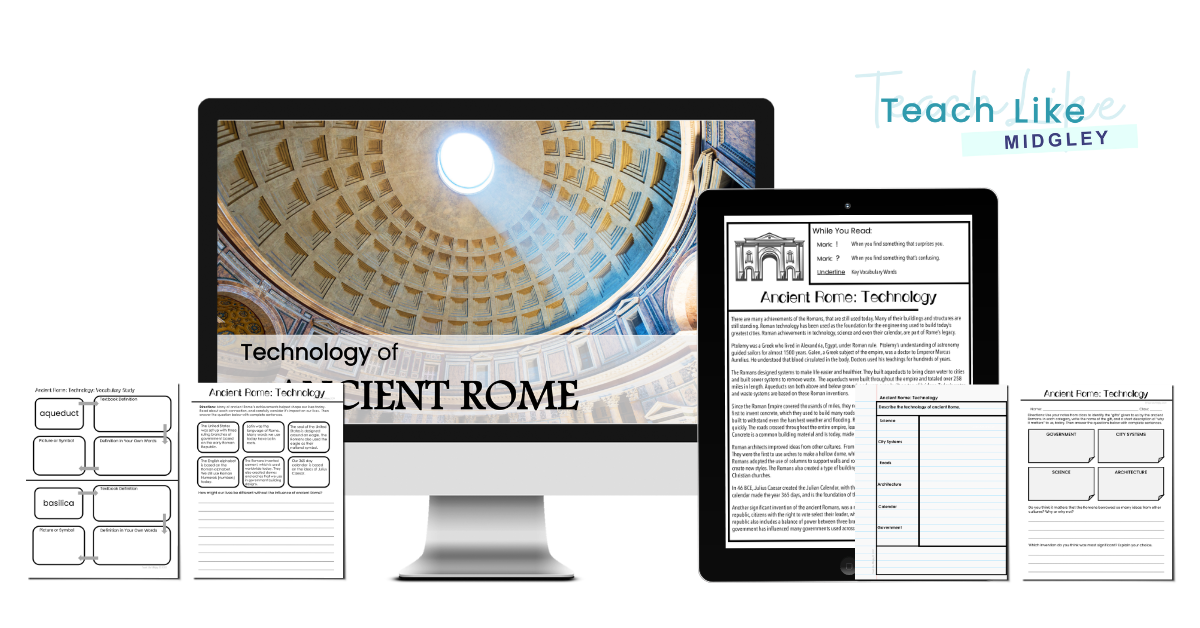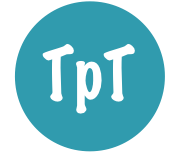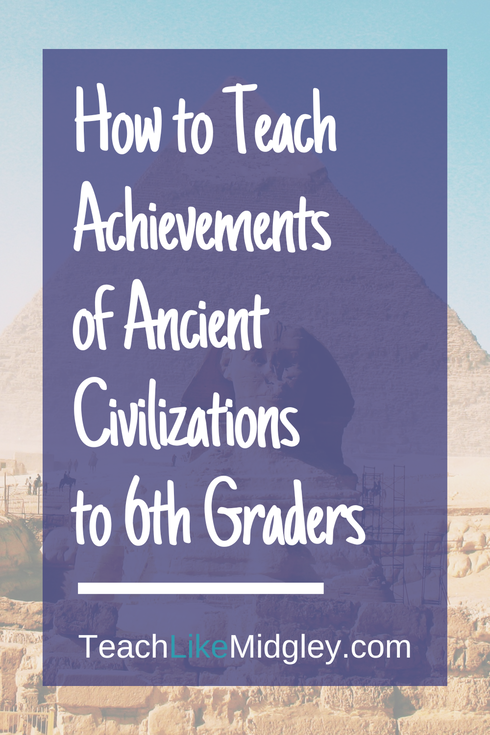How to Teach about the Achievements of Ancient Civilizations to Sixth Graders
Why study history?
This is one of the big questions many history teachers begin their courses with. And for good reason. Why do we bother to learn about what people did thousands of years ago?
There are actually quite a few answers to this question, and most likely they are all correct.
We study history to help us understand other cultures.
We study history to better understand our own society.
We study history to help us understand our own identities.
We study history so that it can provide insight into present-day problems.
We study history to better understand the change that has happened over time.
This is one of the big questions many history teachers begin their courses with. And for good reason. Why do we bother to learn about what people did thousands of years ago?
There are actually quite a few answers to this question, and most likely they are all correct.
We study history to help us understand other cultures.
We study history to better understand our own society.
We study history to help us understand our own identities.
We study history so that it can provide insight into present-day problems.
We study history to better understand the change that has happened over time.
The answers are seemingly endless. And they are all true on some level. Making ancient history relevant to today’s youth can seem like a challenging task.
But there are so many aspects of our lives today, that stem from the achievements of people from long ago. To truly appreciate all that we have now, it helps to see where it came from and what life was like before.
What is an Achievement?
When we study ancient societies, it’s easy to become fixated on monumental structures, especially those that are still standing today. While structures like the Pyramids of Giza and the Great Wall of China are exciting and even mesmerizing, they do not represent the achievements of their respective societies in their entirety.
An achievement or contribution of an ancient civilization exists in many forms. It could be crafted in one of the arts, as in plays, poetry, or even literature. It could also be considered a new piece of technology or invention to make doing something quicker and easier. Or even a discovery that is knowledge based and in the area of mathematics or medicine. These achievements no doubt have had a larger impact on our lives today, than a stone structure.
Yes, doing a STEM/STEAM project where you build a pyramid from sugar cubes and toothpicks can be fun, engaging, and promote critical thinking, problem solving, and leadership. But I would caution you against spending all your time on this approach.
An achievement or contribution of an ancient civilization exists in many forms. It could be crafted in one of the arts, as in plays, poetry, or even literature. It could also be considered a new piece of technology or invention to make doing something quicker and easier. Or even a discovery that is knowledge based and in the area of mathematics or medicine. These achievements no doubt have had a larger impact on our lives today, than a stone structure.
Yes, doing a STEM/STEAM project where you build a pyramid from sugar cubes and toothpicks can be fun, engaging, and promote critical thinking, problem solving, and leadership. But I would caution you against spending all your time on this approach.
Core Content
Your first step is providing students with core content about the achievements of the ancient civilization you are about to study. This could come in many different forms: textbook, supplemental readings, learning magazines, online resource, etc.
Most curriculums will include some general information, such as the medical advances of ancient India with setting broken bones to heal properly and the first inoculations. Both of which are very important to our own survival today.
If you’ve been around here for a while, then you know that when I started teaching sixth grade, I had little to no resources available to me. This experience has been my motivation and driving force behind writing this blog and creating ready-to-roll resources for teachers like you. Each of my Ancient Civilization Lesson Sets comes with a reading passage and a PowerPoint presentation to help you provide core content to your students.
You will also want to make sure you identify key vocabulary terms that students should know to help them further their understanding.
If you’ve been around here for a while, then you know that when I started teaching sixth grade, I had little to no resources available to me. This experience has been my motivation and driving force behind writing this blog and creating ready-to-roll resources for teachers like you. Each of my Ancient Civilization Lesson Sets comes with a reading passage and a PowerPoint presentation to help you provide core content to your students.
You will also want to make sure you identify key vocabulary terms that students should know to help them further their understanding.
Student Processing Activities
After students have been presented with the core content, next they need the opportunity to process and work with the new information. Writing summaries, completing diagrams or charts, manipulating material in different activities or a worksheet that reinforces key concepts are all excellent choices.
By all means, have some fun learning about the monumental, impressive structures that were built so long ago. They are AMAZING! But consider focusing on the 5 W’s of the monument, and then moving into other impressive achievements.
Another great way to have students work with new content is to have them complete an activity in their interactive notebook with a foldable activity or exercise.
Each of my Ancient Civilization Lesson Sets comes with a worksheet and an activity. While the worksheets are intended to reinforce key concepts, the activities are designed to help your students take the material one step further in their level of thinking.
By all means, have some fun learning about the monumental, impressive structures that were built so long ago. They are AMAZING! But consider focusing on the 5 W’s of the monument, and then moving into other impressive achievements.
Another great way to have students work with new content is to have them complete an activity in their interactive notebook with a foldable activity or exercise.
Each of my Ancient Civilization Lesson Sets comes with a worksheet and an activity. While the worksheets are intended to reinforce key concepts, the activities are designed to help your students take the material one step further in their level of thinking.
Reinforce Key Concepts
The final step to teaching about the achievements of ancient civilizations is to CONSTANTLY revisit and reinforce key concepts.
Every day, every lesson starts the same way, with a brief review of what we’ve already studied. Sometimes this looks like rapid fire questioning while I collect homework. Other days it’s a brief summary.
But it also includes going back and asking students to recall information during new lessons. Especially when we learn about the golden age of a civilization, we are talking about a time when achievements and advancements were made in the areas of art and technology.
You may find your students are struggling to remember certain things, this is a flag for you, that they need more practice with the content. Maybe some extra vocabulary work may benefit.
As you progress in your lessons, you also want to help your students take their thinking to the next level and utilize advanced questioning. For each Lesson Set, I developed a set of 5 Questions that follow the lines of Bloom’s Taxonomy Questioning Techniques.
Every day, every lesson starts the same way, with a brief review of what we’ve already studied. Sometimes this looks like rapid fire questioning while I collect homework. Other days it’s a brief summary.
But it also includes going back and asking students to recall information during new lessons. Especially when we learn about the golden age of a civilization, we are talking about a time when achievements and advancements were made in the areas of art and technology.
You may find your students are struggling to remember certain things, this is a flag for you, that they need more practice with the content. Maybe some extra vocabulary work may benefit.
As you progress in your lessons, you also want to help your students take their thinking to the next level and utilize advanced questioning. For each Lesson Set, I developed a set of 5 Questions that follow the lines of Bloom’s Taxonomy Questioning Techniques.
Ready to Roll Materials
Now you know exactly how I teach about the achievements of ancient civilization to my sixth graders and you are ready to do the same!
But if you are struggling to find the materials you need – well, you know I’ve got you covered! No matter which unit you are about to teach, check out my TpT Store for all the Lesson Sets designed to help you teach Arts and Technology!
But if you are struggling to find the materials you need – well, you know I’ve got you covered! No matter which unit you are about to teach, check out my TpT Store for all the Lesson Sets designed to help you teach Arts and Technology!
You May Also Like...

Welcome! I'm Hillary Midgley, a veteran 6th grade teacher.
I create educational materials and develop curriculum for other teachers. I specialize in teaching students how to learn through my Study Skills Curriculum. I have established fundamental classroom systems and structures for teachers to help them streamline their classroom. And my passion is teaching ancient history through engaging activities with foundations in academic skills. Here you will find resources on all of these topics and more. Learn more about me here.
|

